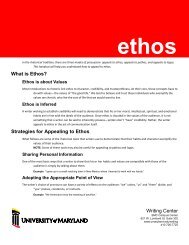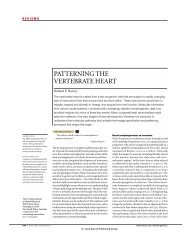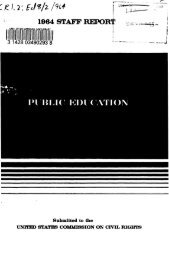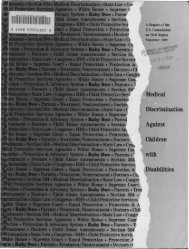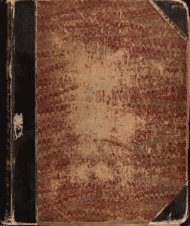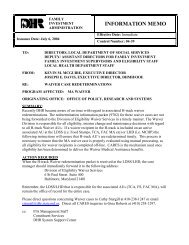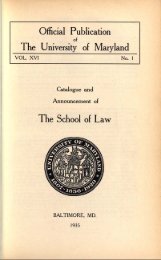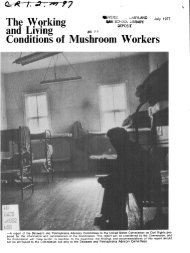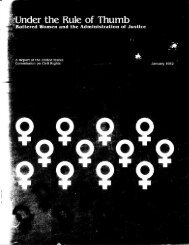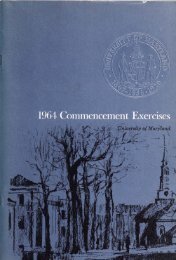1961 US Commission on Civil Rights Report Book 2 - University of ...
1961 US Commission on Civil Rights Report Book 2 - University of ...
1961 US Commission on Civil Rights Report Book 2 - University of ...
You also want an ePaper? Increase the reach of your titles
YUMPU automatically turns print PDFs into web optimized ePapers that Google loves.
sp<strong>on</strong>sored; others are private, volunteer efforts. They may be classified<br />
into two groups. The first is c<strong>on</strong>cerned with differences in individual<br />
pupil achievement present in schools that include both educati<strong>on</strong>ally<br />
handicapped and high achieving children. The sec<strong>on</strong>d, with programs<br />
aimed at improving the training <strong>of</strong> all children in a school.<br />
CLOSING THE GAP<br />
Ability grouping<br />
As indicated above, when white and Negro children are first brought<br />
together in school, an unusually wide spread in scholastic performance<br />
is to be expected. Many educators believe that the performance <strong>of</strong><br />
all is better when children are grouped so that slow achievers do not<br />
hold others back and high achievers do not discourage those who<br />
cannot keep up—while the average child proceeds at his own pace unhampered<br />
by either. Basically there are four types <strong>of</strong> ability groupings<br />
within a school system: (i) by schools; (2) by special programs within<br />
individual schools; (3) by classes within individual schools; and (4) by<br />
groups within classes. Each will be discussed briefly.<br />
By schools.—Special schools for academically talented students are<br />
not new, particularly at the high school level. Good examples are<br />
Baltimore's Polytechnic Institute, a special school for boys preparing for<br />
engineering colleges; and Western High School, for girls preparing for<br />
college—admissi<strong>on</strong> to both is based <strong>on</strong> high scholarship. They were<br />
established l<strong>on</strong>g ago for whites <strong>on</strong>ly, but qualified Negroes are now<br />
admitted to both. 4<br />
The criteria set forth in the pupil placement laws <strong>of</strong> many Southern<br />
States G would certainly permit separate schools for pupils <strong>of</strong> different<br />
scholastic aptitude and achievement. In the absence <strong>of</strong> racial discriminati<strong>on</strong>,<br />
this would seem to be c<strong>on</strong>stituti<strong>on</strong>ally unobjecti<strong>on</strong>able. Apparently<br />
no southern school system has used a pupil placement law in this<br />
manner. Many educators have testified that Negro pupils fall within<br />
all ability groups, although they are found in prep<strong>on</strong>derant numbers<br />
am<strong>on</strong>g the low achievers. 6<br />
By programs.—Track systems, particularly at the high school level,<br />
are a familiar method <strong>of</strong> ability grouping by scholastic program. Introduced<br />
into the Washingt<strong>on</strong>, D.G., schools after complete desegregati<strong>on</strong><br />
by rez<strong>on</strong>ing, 7 this approach was said to <strong>of</strong>fer reassurance to school patr<strong>on</strong>s<br />
that mixing white and Negro pupils would not impair the educati<strong>on</strong>al<br />
opportunity <strong>of</strong> any<strong>on</strong>e. 8 Other cities that have tried it, before or after<br />
118



